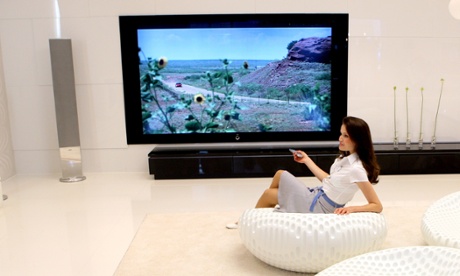
In the UK we spend, on average, three hours and 55 minutes watching TV every day. That’s more than 27 hours a week, or 59 days a year. Since 2004, we've bought 60m flatscreen TVs and we have an average of 1.86 televisions per household. With this much time spent in front of the box, buying energy-efficient models can certainly help to reduce your energy consumption and, of course, your electricity bill.
So, if you’re considering buying a new TV – and recycling your old one – here are some things to look out for.
Look at the energy label
By law, all televisions for sale must display the EU energy label. If you found a TV you liked rated as A or B you might think you were picking a TV that was pretty good in terms of efficiency. Sadly, you’d be wrong. The current energy label for TVs runs from A+++ (most efficient) to D (least efficient), making the A- and B-rated TVs pretty average in terms of energy efficiency. Look for an A+ or an A++ TV wherever possible.
Size does matter
In the past 10 years, the size of the screens we are buying has doubled. According to Telescope, 70% of the TVs purchased in 2013 were classed as ‘big’ (26-32in) and 16% as ‘jumbo’ (43in or more). Generally, the bigger the screen the more energy needed to power, so this is a consideration if you want to save energy. It’s also worth considering that the optimum viewing distance for a 40in TV is two metres and three metres for a 50in set. So depending on the space you have, bigger won’t always mean better.
Go LED
LED screens are the most efficient mainstream technology. They’re similar to liquid crystal display (LCD) screens, but are backlit by light emitting diodes that save energy. Plasma screens are great for tracking fast-moving pictures on a large screen, but consume a lot more energy – typically two to three times as much as an LED TV.
Whatever type of TV you have there are things you can do to reduce how much energy it uses:
Switch it off
The Energy Saving Trust estimates that UK households spend between £50 and £86 a year on appliances and electronics on standby. TVs are one of those appliances often left on standby, consuming energy when not even in use. Make sure you switch your TV off at its power switch or at the socket.
Change your settings
Your new TV will arrive with factory settings which are often brighter than you’ll need at home, so have a look at whether they need adjusting. Reducing brightness levels significantly lowers energy consumption.
Idle modes such as fast play or quick start can contribute about 25W on average to standby power consumption as a user-selected option. Many new TVs also have an eco mode which you might want to consider selecting.
If your TV has an ambient light sensor feature, the sensor adjusts the backlight of the TV according to how dark or light the room is. Watching the TV with the lights off, can reduce energy use by 30 to 50% if this feature is enabled.
Use the screen blanking feature if you use your TV to listen to digital radio channels. This feature switches off the screen if left idle for a set period of time.
Finally, if you are going to get a new television, remember to dispose of your old set responsibly, passing it on to enable someone else to reuse it (if it works) or recycle it via your local council (if it doesn’t).
For more advice on getting the most from your appliances, visit the Top10 website.
Lizzie Kenyon is from Keep Britain Tidy.
Interested in finding out more about how you can live better? Take a look at this month's Live Better Challenge here.
The Live Better Challenge is funded by Unilever; its focus is sustainable living. All content is editorially independent except for pieces labelled advertisement feature. Find out more here.

